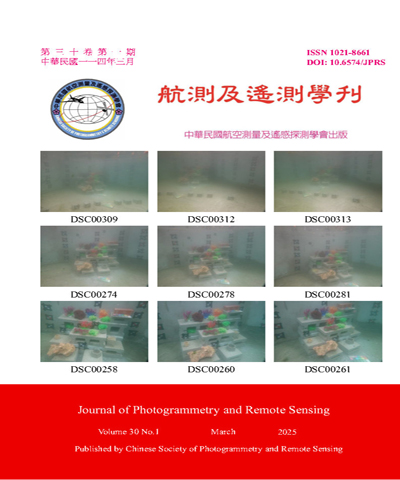
航測及遙測學刊/Journal of Photogrammetry and Remote Sensing
中華民國航空測量及遙感探測學會,正常發行
選擇卷期
- 期刊
This paper discussed an auto matic building objectivization method for generating a large number of 3D LOD2 building models by integrating 2D geospatial information, airborne LiDAR point cloud, a DEM, aerial vertical and oblique images. The procedure was divided into the following four stages. First, the elevation and ground floor elevation corresponding to each building in shapefile were determined based on LiDAR point cloud data within each building outline and a DEM, and they were appended into a building outline shapefile. Second, individual 3D LOD1 building models with the standard file format of object file presented by triangulation networks were transformed from every single building outline shapefile into the object file, and even 3D LOD1 building models with any atriums could be produced. Third, from aerial vertical and oblique images as well as whole 3D LOD1 building models, the texture corresponding to each 3D LOD1 building model triangulation was determined by the most appropriate images for texture mapping. Fourth, each complete 3D LOD2 building objectivization model was constructed by splitting and packing its corresponding building texture images into a single image for data compression. Finally, the objectivization models were imported into the WebGL platform for demonstrating the advanced application in this study.
- 期刊
大量多視角影像於密匹配計算處理上較為複雜而繁瑣,且針對每一像對分別計算其初始視差值,耗損的時間成本亦相對增加;再者,具多組像對重疊條件之多視角影像,倘未善加調製其交會幾何,產製之場景點雲即便具有描述幾何多餘觀測特性,然而點位的不精確性以及較大的離散度亦無助於後續空間資訊之應用。對此,本研究提出一系列優化作業模式並區分為三大主軸:建立影像群聚關係、視差傳遞策略和點雲精化策略等。業經兩組實際資料驗證其功效及可行性,說明所研擬方法產製之點雲能有效描述場景幾何,且於兩測試區域之像對計算總量部分,減少約為44%及14%,而針對其時效提升部分則達80%以上。
- 期刊
為了更合理地描述地面雷射掃描儀系統性誤差,本研究提出自率定法結合個別組件校正的混合模式校正理論,共採用FARO S350、Trimble SX10與RIEGL VZ-400進行測試。根據t-test(95%信心區間)結果,使用系統性誤差改正參數的確能有效描述儀器系統性誤差模式,其中常數項與線性項改正參數已足以描述本研究三款掃描儀的系統性誤差模式,而帶入個別組件校正得到的參數更能達到約制的效果,呈現本研究提出之理論具有更謹慎地進行地面雷射掃描儀校正與評估系統性誤差分析的潛力。
- 期刊
地下管線資料管理流程分為外業資料取得及內業資料處理,傳統方式於外業會於現地繪製施工現場竣工圖,資料較片面零碎。利用攝影測量技術建立三維模型,可紀錄現地鉅細靡遺資訊且可獨立完成。內業資料處理需要大量人力進行資料輸入並反覆檢核,以避免造成資料錯誤。本文採用python/GDAL開發一套數位管線資料建置流程,利用一般攝影器材獲得影像並建立三維模型,於模型中進行數化及屬性資料建置,依使用者選定之設施物類別自動建立相對應欄位並自動檢核,包含基本輸入規則及邏輯性檢核,輔助改善管線資料管理方式,僅需1或2人即可完成,可達省時、省工之數位化地下管線管理流程。

